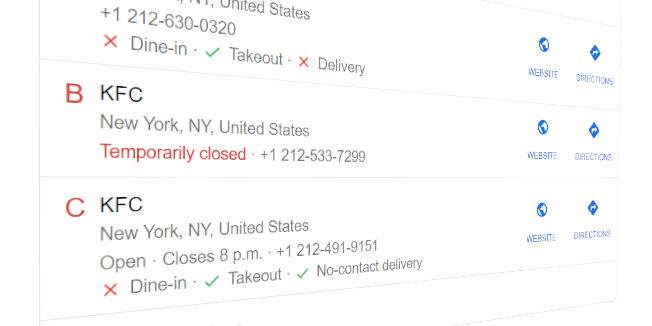Last year, most people were unaware of attributes despite them being a feature of Google My Business (GMB) in many business categories. They provided useful information to consumers (and some handy SEO side-effects) but were underutilised. It was not until the global onset of COVID-19 that Google attributes suddenly became a critical local optimisation strategy. In fact, it became a major detriment to not utilise attributes on your listings.
By now, most users have encountered Google attributes as a format for businesses to share snippets of information during the pandemic. Restaurants, in particular, would not have been able to continue trading without the dine-in, take out, and delivery attributes made clear on their profiles, while medical practitioners have had to quickly specify to their patients whether or not they offer teleconferencing or virtual health. Seeing the rising importance of attributes, Google has pivoted its 2020 updates to make attributes a staple of every business profile in every category.
A new essential in our new normal
Google attributes have existed for a long time and were initially deployed by the hospitality industry. Today, no hotel listing is complete without attributes specifying decision-critical amenities such as WiFi, airport shuttles, and included breakfasts. Although attributes that focus on business features, payment options, and accessibility have been available in GMB from the beginning, their uptake was low until global events brought attributes into the spotlight (think curbside pickup). They’re now a mainstay for all GMB profiles.

So, what does that mean for multi-location businesses? As Google acknowledges that attributes have a greater SEO impact than ever before (the search giant prioritises listings that utilise the feature above listings that don’t), brands can no longer focus on COVID-specific attributes alone. But that’s a lot of work. In fact, there are more than 300 unique Google attributes that cover the entire gambit of unique business features, from being veteran-owned to offering braille menus. Brick-and-mortar businesses could once ignore these attributes without any repercussions. Now they have to reassess their approach in a world where Google gives more weight to attributes—and customers have grown to expect them.
A lack of attributes is beginning to make GMB profiles look incomplete in the same way a missing image or website URL does. Customers are judging a business’s legitimacy on factors like attributes, which offer easily accessible information above everything else. As a result, attributes are fast becoming table stakes in local search, not just an optional optimisation feature.
Automated attributes? Maybe not.
Acknowledging the importance of attributes—especially for restaurants and especially during the pandemic—Google attempted to automatically assign this feature to listings. Its efforts had mixed results, however: some listings were handed features they simply didn’t offer (e.g. delivery), while others were missing attributes they did offer. In short, it created the same kind of confusion as “hours may differ” messaging, causing users to second guess the information they were being shown.

Unfortunately, missteps like these have real-world consequences. We’ll never know how many times a missing attribute resulted in a lost customer, or what kind of resources retailers had to divert after being incorrectly assigned the “curbside pickup” attribute (it can take a lot of time to resolve erroneous orders, and even longer to placate disappointed customers). For now and into the foreseeable future, attributes are most definitely a feature that GMB account holders should prioritse. But that creates its own challenges.
Leave it to the experts
Businesses with multiple locations will have their work cut out to keep up with this latest GMB feature. Regardless of how similar your many locations may be, there will always be subtle distinctions from store to store that now have to be accounted for with attributes: languages spoken, accessibility, parking, and even seasonal attributes such as holiday gift wrapping or patio dining.
Crucially, this evolution is not being driven by users alone: it is Google telling businesses what it wants them to focus on. Each successive update is giving attributes more prominence, more weight, and more ranking emphasis. Unfortunately, it is both time-consuming and labor-intensive for distributed businesses to keep up.
As experts in local listings management, we’re ideally equipped to handle attribute management for even the largest brick-and-mortar brands. We continually ensure that each and every one of our managed listings is assigned the attributes it requires, and gains new attributes as they appear or come into relevance by the season. And the best part? It can all be managed directly via Google’s API.
You’d be forgiven for thinking that attributes came out of nowhere—and that they’re the last thing you want to add to your ongoing to-do list. But we keep up with these changes in local search ecosystem so our clients don’t have to. Want all the benefits of attributes without the endless hours of maintenance and optimisation? Let’s talk.




